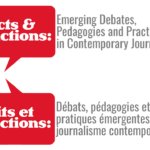How to make your journalism portfolio stand out
Editors and reporters weigh in on how journalism students can put together the best possible portfolio.
By Brennan Reid, Student Lounge Editor
The Canadian Association of Journalists hosted a portfolio review in Toronto on Monday, where students and recent grads could have their portfolios reviewed by professional journalists.
What makes a portfolio stand out from the rest? J-Source talked to Huffington Post Canada national reporter Sunny Freeman, Maclean’s reporter Nick Taylor-Vaisey and Huffington Post Canada managing editor Kenny Yum to find out.
Our experts agreed that your portfolio must be diverse. “Sell yourself as well rounded,” said Freeman. “Even if you want to work at a newspaper, show them work in radio.”
Your portfolio should demonstrate the range of skills you have and convince employers that you can bring something to the newsroom they don’t already have. Showcase a variety of different styles, from long-form writing to short clippings, podcasts to web videos and everything in between.
Be sure to include a range of different types of reporting, too, from sports to in-depth features and arts stories to hard news, to show that you’re adaptable. Don’t send in variety of stories just to be diverse, though. Quality is more important than quantity, and you want to send in your best work.
It’s also important to tailor your portfolio for each job. While having a diverse portfolio is good, if you’re applying to a sports organization, most of your pieces should be about sports. If you’re applying for a feature writer position, most of your pieces should be well-crafted features, with a couple of shorter news or other pieces to showcase your adaptability.
Freeman said your portfolio should tell a story about you and your personal brand. It should show employers that you can craft incredibly polished pieces relating to the job, but that you are adaptable and are able to handle anything that your employer could throw at you.
After considering the package as a whole, Taylor-Vaisey said he concentrates on the ledes of individual stories.
“You can’t write a good lede for a bad story,” he said. Ledes are the first impression of your story, and if they’re bad, then no potential employer will read through the rest of what might be an excellent story. Make sure to choose clippings that make that best first impression and convinces your reader to read on. For feature stories, Taylor-Vaisey said he’s looking for a “clever kicker at the end.”
After you’ve picked out your clippings, it’s important to think about how best to format your portfolio. Most portfolios are sent electronically these days, but that doesn’t mean proper paper formatting goes out the window.
Yum said he prints out the portfolios he receives and reads them on paper.
“I spend 20 seconds to a minute on your portfolio,” said Yum. “Presentation is huge.”
If you have a digital scan of a newspaper clipping, make sure it fits on one page without being illegible. For stories published on the web, copy them into a text document, and insert a link to the story in the document.
The key here is not to annoy the person reading your portfolio—no employer wants to be printing out a confusing mess that takes time to sort.
If you’re a journalism student or recent grad without many published pieces, submit what you have that best represents what you can and want to do. Above all, submit what you’re proud of—if a piece you wrote for class is better than one that you had published, submit the one that’s better, said Freeman.
“Make sure it’s top shelf,” said Taylor-Vaisey. “Everyone has to start somewhere.”
Yum, however, likes to see published pieces because it shows that you have an audience. In the end, go with your gut: don’t submit one piece just because it was published if you have a better, unpublished piece to offer.
Remember, your portfolio should showcase you: who you are, what you can do and what you offer. As Taylor-Vaisey said, “I want to see a lot of you.”




